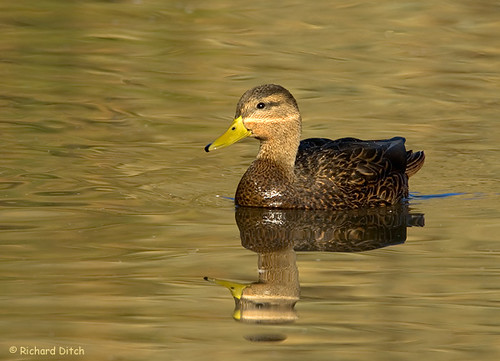tags: mystery bird, identify this bird, birds, mystery bird, bird ID quiz
[Mystery bird] Mallard, Anas platyrhynchos, photographed in Arizona. [I will identify this bird for you tomorrow]
Image: Richard Ditch, 2005 [larger view].
Date Time Original: 2005:12:10 08:20:56
Exposure Time: 1/400
F-Number: 7.10
ISO: 200
Please name at least one field mark that supports your identification.
Rick Wright, Managing Director of WINGS Birding Tours Worldwide, writes:
What seems at first regard a completely straightforward identification leads us down a tangled path indeed. Nearly everyone will have seen in this large, intricately patterned, yellow-billed dabbler a Mallard -- but the question quickly becomes just what kind of "Mallard" we're looking at here.
The extreme darkness of this bird's plumage -- most particularly of the tail and the tertials--rules out a simple garden-variety "northern" Mallard; furthermore, the bright yellow bill identifies it as a male, and any drake "northern" Mallard, even in deepest eclipse, would be more colorful than this individual.
Like so many visitors to southeast Arizona, we might at first think of American Black Duck; but apart from the fact that that species does not occur in the American southwest, our quiz bird is a hint too pale, and its bill too cleanly yellow, for that eastern species. Mottled Duck, a conceivable vagrant to the southwest, would show an unstreaked neck and a clear black spot at the base of the bill. We're left with Mexican Duck, which is generally intermediate in plumage between Mottled and American Black Duck, an identification that suits the mystery bird perfectly -- from this angle at least.
Confidence in the identification of Mexican Duck in southeast Arizona is an elusive goal. The party line is that no "pure" Mexican Ducks -- whatever that might mean -- occur in the region, and in fact, close examination of most candidates ends up revealing a curled uppertail covert, a hint of green in the crown, a whitish tail feather, or a big white tip on a greater covert: all customarily considered signs of intergradation with "northern" Mallard.
The situation is even more complicated than these trivial difficulties of field identification suggest. We simply don't know what a Mexican Duck "is": whether a taxon deserving of specific status, or one of the "hen-plumaged" races of Mallard, or something completely different. Recent genetic studies suggest that the closest evolutionary relative of Mexican Duck is not northern Mallard but rather the western population of Mottled Duck; if that is true, the logical conclusion must be either that Mallard and Mexican Duck are not the same species, or that Mottled Duck and Mallard are. In any event, the world's "mallards" are as much of a challenge to any species concept as the juncos or the crossbills or the "winter" wrens.


The greenish bill, dark body, and mallard shape identify this bird as my favorite duck...the Black Duck.
Of course, it could be a Mottled duck. I am not good enough to tell from that picture. AZ would be pretty far west for the average Black duck.
I'm going to call that a Mexican duck (subspecies of the mallard). An adult male. I'm going mostly on the head and neck markings, and the beak color.
FYI.
The bright line on the face across the cheek is a light reflection from the water and not a plumage feature.
"Obviously"... a female mallard wearing a male's beak like a Groucho nose. I can't think what else that white band might be....
Yellow bill. Dark body.
Candidates:
American Black Duck
Mexican Duck
Mottled Duck.
The problem is we can't see the speculum. Should we be seeing the white edging if Mexican duck? Probably - so I'll rule that out.
Mottled duck usually has a black gape spot - again not seen.
Just based on the body colour I'd say Black Duck, esecially with the dark tail.
Black Duck - the stripe through the eye, yellow bill, tannish head and darker body.
black bellied whistling duck
Mallard - Mexican population (F).
Streaked throat and lack of spot on gape (at base of bill) indicates a Mallard rather than a Mottled Duck suggested by the fairly light crown and buff on the throat. I think the gape spot is the most distinctive or at least clearest field mark.
Another vote for Mexican ssp of Mallard. Mottled duck has a dark spot where the gape meets the face, and the Black Duck is a little darker and normally found only in the eastern US.